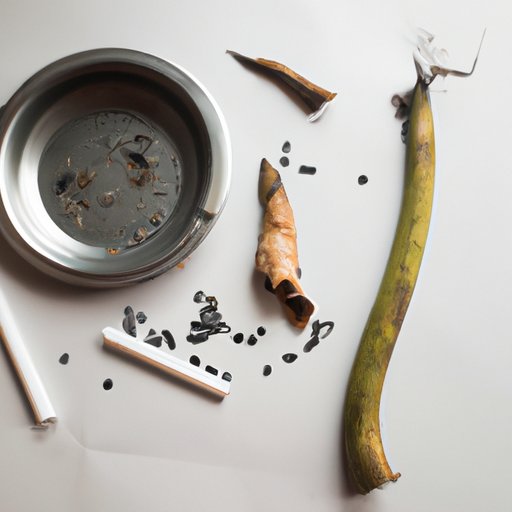
I. Introduction
When you’re in the middle of washing dishes and food scraps start to accumulate in the sink, a clogged garbage disposal can be frustrating and time-consuming to deal with. Not only does it create an unpleasant odor, but it also obstructs the sink, causing water to back up and making it difficult to clean. In this article, we’ll provide you with a step-by-step guide to help you get your garbage disposal running smoothly again.
Before you start, we want to stress the importance of following proper safety procedures and avoiding harmful chemicals that can damage your pipes.
II. Step-by-Step Instructions
Follow these simple steps to clear out your garbage disposal:
1. Turn off the power to the garbage disposal
Make sure you turn off the electrical power to your garbage disposal before attempting to unclog it. This is a crucial step to ensure your safety during the process.
2. Disconnect the drain pipes
Using pliers, loosen the nuts that hold the pipe connections in place, allowing you to easily remove and inspect them for any blockages.
3. Use a flashlight and pliers to remove any visible debris
If you can see debris lodged in your disposal, use a flashlight and pliers to carefully remove it. Be sure not to use your hands, as the blades can be sharp and cause injury.
4. Deploy a plunger or use natural DIY remedies like baking soda and vinegar or boiling water
If you don’t see any visible blockages, try using a plunger or natural DIY remedies like baking soda and vinegar or boiling water to break up any clogs. Simply pour half a cup of baking soda followed by half a cup of vinegar down the drain, and then let it sit for around 30 minutes before flushing it with boiling water. Alternately, try pouring a pot of boiling water down the drain to clear things out.
5. Reconnect the drain pipes and turn on the power
Finally, reconnect the drain pipes and turn on the power to the garbage disposal. If it’s still clogged, repeat the process until the pipes are running smoothly.
III. DIY Remedies
One of the easiest ways to unclog a garbage disposal is to use natural DIY remedies that won’t damage your pipes. Some popular remedies include:
Baking soda and vinegar
As mentioned, combining baking soda and vinegar can work wonders in removing clogs. The mixture reacts to form a bubbling reaction which can break down any blockages.
Boiling water
If you have items stuck in the disposal that can easily be dislodged, pouring boiling water down the drain can melt grease that may be blocking the pipes.
Plunger
Using a plunger can force water through the disposal and help break up any obstruction, allowing it to flow through more easily.
IV. Natural Drain Cleaners
The use of harsh chemicals can be hazardous to your health as well as your environment, and may also weaken your pipes. Instead, opt for natural drain cleaning products with eco-friendly ingredients like enzymes and bacteria. Some popular options include Bio-Clean and Thrift Drain Cleaner.
When choosing a product, always be sure to read the label and follow the exact instructions for maximum efficiency.
V. Addressing the Root Cause
While clearing your pipes is important, it’s essential to maintain your garbage disposal by taking preventative measures to avoid future clogs. Here are some tips:
Avoiding Certain Foods
Avoid putting fibrous, starchy, and oily foods like potato peels, eggshells, and grease in your disposal, as they can cause clogs.
Running Cold Water
Before and after use, run cold water down the drain for around 15 seconds to help clean out any remaining scraps.
Avoiding Common Pitfalls
Don’t pour oil or grease down your garbage disposal, as it can stick to the blades and cause further clogs.
VI. Troubleshooting Guide
More serious issues like jams or leaks may require a bit more effort to resolve. Here are some tips for identifying and troubleshooting these problems:
Manually turn the blades
If your disposal is jammed, try using an Allen wrench to manually turn the blades back and forth to unstick them.
Check for leaks
If the pipes aren’t clogged, but you’re still seeing water or food debris come out of the disposal, it’s important to check the seals for damage, as well as the pipe joints for any loose connections that may be causing the issue.
Call in a Professional
If you have tried all of the above tips and are still having issues, it may be time to call in a professional plumber. They have the expertise and equipment to diagnose and fix the problem quickly and safely.
VII. Mention Professionals
Hiring a professional plumber can be helpful for more complex issues, especially if you’re unsure about how to proceed. To find the right plumber, ask for recommendations from friends and family, check out online reviews, and get quotes from multiple providers.
VIII. Clear Visuals
To help simplify the instructions, clear visuals can be incredibly helpful in demonstrating the steps. Simple diagrams, infographics, and photographs can provide an easy-to-follow guide even for those without much plumbing experience.
IX. Conclusion
A clogged garbage disposal is an annoying problem to have in the kitchen, but it doesn’t have to be a major issue. By following our step-by-step guide and using natural remedies, you can unclog your pipes with ease. Remember to avoid harmful chemicals, take preventative measures to avoid future clogs, and call in a professional if you need assistance. With some care and attention, your garbage disposal can continue to provide efficient service for years to come.





